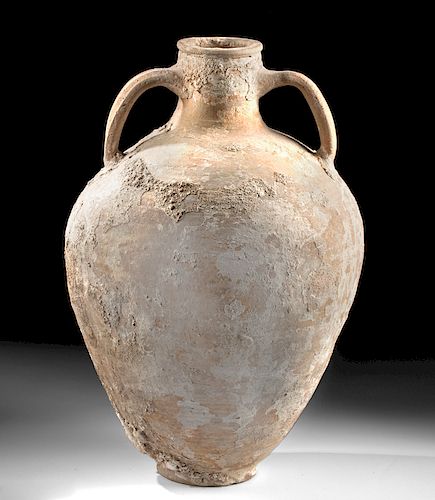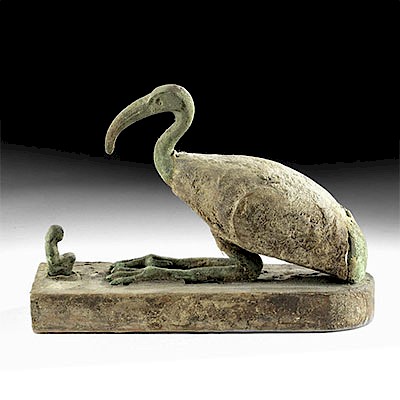Sea Salvaged Roman Pottery Transport Amphora
Lot 71c
About Seller
Artemis Gallery
686 S Taylor Ave, Ste 106
Louisville, CO 80027
United States
Selling antiquities, ancient and ethnographic art online since 1993, Artemis Gallery specializes in Classical Antiquities (Egyptian, Greek, Roman, Near Eastern), Asian, Pre-Columbian, African / Tribal / Oceanographic art. Our extensive inventory includes pottery, stone, metal, wood, glass and textil...Read more
Estimate:
$2,000 - $3,000
Absentee vs Live bid
Two ways to bid:
- Leave a max absentee bid and the platform will bid on your behalf up to your maximum bid during the live auction.
- Bid live during the auction and your bids will be submitted real-time to the auctioneer.
Bid Increments
| Price | Bid Increment |
|---|---|
| $0 | $25 |
| $300 | $50 |
| $1,000 | $100 |
| $2,000 | $250 |
| $5,000 | $500 |
| $10,000 | $1,000 |
| $20,000 | $2,500 |
| $50,000 | $5,000 |
| $100,000 | $10,000 |
| $200,000 | $20,000 |
About Auction
By Artemis Gallery
Oct 31, 2019
Set Reminder
2019-10-31 10:00:00
2019-10-31 10:00:00
America/New_York
Bidsquare
Bidsquare : Fine Antiquities, Asian, Ethnographic Art
https://www.bidsquare.com/auctions/artemis-gallery/fine-antiquities-asian-ethnographic-art-4581
Our Halloween Day auction features classical antiquities, ancient and ethnographic art from cultures encompassing the globe, plus fine art. Artemis Gallery info@artemisgallery.com
Our Halloween Day auction features classical antiquities, ancient and ethnographic art from cultures encompassing the globe, plus fine art. Artemis Gallery info@artemisgallery.com
- Lot Description
Roman, Imperial Period, ca. late 2nd to 3rd century CE. A sizable buffware pottery transport amphora with a circular base, inverted piriform body, a rounded shoulder that tapers to a squat, cylindrical neck, a thick rim, and a pair of applied strap handles arching from neck to shoulder. The vessel displays dozens of horizontal exterior ribs - formed during the wheel-throwing process - that indicate it was created with a utilitarian purpose in mind. Transport vessels like this example were typically not adorned with painted decorations or applied details, though some display stamped markings denoting the materials contained within. Size: 12.1" W x 17.4" H (30.7 cm x 44.2 cm)
Lacking its cork and pitch stopper, the original contents of this amphora are unknown; based on the conical size and shape, it was most likely used to transport stewed fruit, salted fish, or other foodstuffs (larger ones were for olive oil or wine). Amphorae formed the basis of the Roman economy as storage vessels for transporting goods throughout the Empire, with examples found from North Africa to Britain.
For a stylistically similar example with a conical base, please see The Metropolitan Museum of Art, accession number 74.51.2434.
Provenance: private J.H. collection, Beaverton, Oregon, USA
All items legal to buy/sell under U.S. Statute covering cultural patrimony Code 2600, CHAPTER 14, and are guaranteed to be as described or your money back.
A Certificate of Authenticity will accompany all winning bids.
We ship worldwide and handle all shipping in-house for your convenience.
#149619Repair to one handle, with small chips along break line. Nicks to base, body, rim, and handles, with darkening to some areas of buffware surface, and heavy encrustations commensurate with being submerged for centuries. Nice earthen deposits and encrustations throughout.Condition
- Shipping Info
-
All shipping is handled in-house for your convenience. Your invoice from Artemis Gallery will include shipping calculation instructions. If in doubt, please inquire BEFORE bidding for estimated shipping costs for individual items.
-
- Buyer's Premium



 EUR
EUR CAD
CAD AUD
AUD GBP
GBP MXN
MXN HKD
HKD CNY
CNY MYR
MYR SEK
SEK SGD
SGD CHF
CHF THB
THB
















